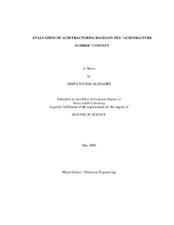| dc.description.abstract | Acid fracturing is one of the preferred methods to stimulate wells in carbonate
reservoirs. It consists of injecting an acid solution at high enough pressure to break
down the formation and to propagate a two-wing crack away from the wellbore. The
acid reacts with the carbonate formation and this causes the etching of the fracture
surfaces. After the treatment, the created etched surfaces do not close perfectly and that
leaves behind a highly conductive path for the hydrocarbons to be produced. We
distinguish the issue of treatment sizing (that is the determination of the volume of acid
to be injected) and the issue of creating optimum fracture dimensions given the size of
the treatment. This is reasonable because the final cost of a treatment is determined
mainly by the volume of acid injected and our goal should be to achieve the best
performance of the treated well. The well performance depends on the created fracture
dimensions and fracture conductivity and might change with time due to various reasons.
This research evaluates two field cases from Saudi Aramco where acid fracturing
treatment has been used to stimulate a carbonate formation. I investigated the following issues: a) how effective was the treatment to restoring the initial productivity, b) how did
the productivity of the well change with time; c) what are the possible reasons for the
change in performance, d) what are our options to improve acid fracture design in the
future?
Based on our research work both near-well liquid drop-out and fractureconductivity
deterioration can impact the production in different proportion. Moreover,
the fracturing model tends to overestimate the fracture conductivity in some cases as
shown in SA-2. Also, the “Acid fracture Number” concept proves to be an effective way
to evaluate the acid fracturing treatment. Several recommendations were made based on
this research work as described in the last part of my thesis. | en |


